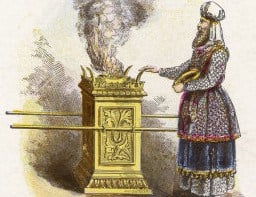At the end of the weekly portion, Tetzaveh, the Torah speaks of the burnt offerings (Heb. qorbanot) and the incense offerings (Heb. qetoret). The Lubavitcher Rebbe, Rabbi Menachem Mendel Schneerson, contrasts these two types of offerings by highlighting their symbolism.
The Hebrew word for a burnt offering or sacrifice, qorban, is etymologically related to the word qarov “close,” qiruv “to bring close” and qerovim “relatives,” as they all share the same root QRB “to be close.” Sacrificial offering (qorban) meant to bring a person who brought it close (qarov) to G‑d.
The Hebrew word for incense offerings, qetoret, literally means “smoke,” “the odor of sacrifice,” or “incense.” However, Rabbi David Kimchi (“Radak”) points out that the word qeturot means “connected” as it is etymologically related to the Aramaic word qeter “to bind” and to the Hebrew word qesher “to bind,” “connection” or “knot.”
The Rebbe points out the difference between sacrifices and incense offerings. The former was supposed to bring a person closer to G‑d. However, “close” is still separate. It is a relative term signifying a degree of separation. Someone who is close is less separate to the one who is far but is separate nonetheless.
The incense offering, however, signified a connection that bound us to G‑d. The Rebbe points out that just as in a knot, one cannot separate one string from another (they are essentially one thing—a knot), one cannot separate people of Israel from G‑d, and that was the symbolism of incense offerings.
I would like to propose another translation for the word qeter—“to entangle” or “entanglement.” I believe the word “entanglement” better captures the multiple meanings of the Hebrew word qeter—“connection,” “bind,” or “knot.”
To me, sacrificial offerings and incense offerings symbolize two types of physical interaction: field and quantum entanglement. Particles interacting through a field—such as a gravitational field or electromagnetic field—can attract each other and get closer together while still being separate particles. Thus, sacrificial offerings (qorbanot) are a metaphor for the field.
The incense offerings (qetoret), on the other hand, offer a metaphor for quantum entanglement, whereby two separate objects become bound (kesher or qeter) together like a knot (qesher). Entangled objects are essentially one object. This is why the incense offerings are so powerful—they represent the eternal unity of G-d and Israel.

nice,
we were having a discussion in biblical Hebrew etymology on KoChaV (star or perhaps light trail per SPI-RALL cosmological redshift hypothesis thus the stars are in the Rakia) ) and KaV a measured line/rope
VaV being a connector as in MiTsVaH connectors.